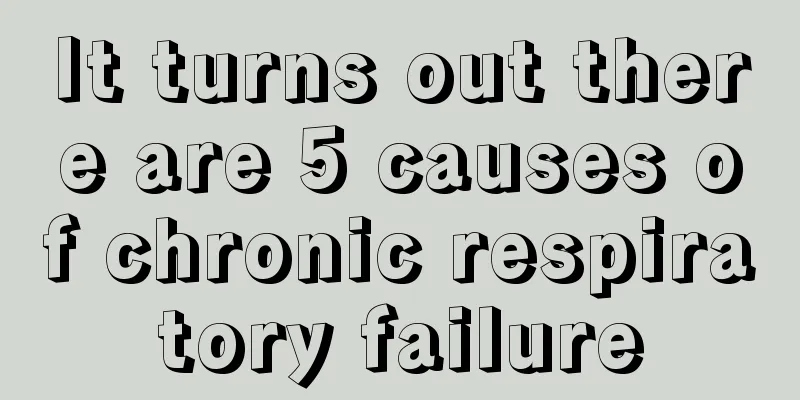It turns out there are 5 causes of chronic respiratory failure

|
Chronic respiratory failure is a very common respiratory disease. Its occurrence is extremely harmful to human health. Therefore, it is particularly important to understand the cause of chronic respiratory failure and prevent it. In fact, in life, there are five reasons that can cause chronic respiratory failure. The first one is respiratory tract lesions. 1. Respiratory tract lesions Bronchitis, bronchospasm, foreign bodies, etc. block the airway, causing insufficient ventilation. Uneven gas distribution leads to an imbalance in the ventilation/blood flow ratio, resulting in hypoxia and carbon dioxide retention. 2. Lung tissue lesions Pneumonia, severe pulmonary tuberculosis, emphysema, diffuse pulmonary fibrosis, adult respiratory distress syndrome (ARDS), etc. can cause a decrease in lung capacity, ventilation, and effective diffusion area, and an imbalance in ventilation/blood flow leading to pulmonary artery shunt, causing hypoxia and/or carbon dioxide retention. 3. Pulmonary vascular disease Pulmonary vascular embolism, pulmonary infarction, etc. cause part of the venous blood to flow into the pulmonary veins, resulting in hypoxia. 4. Thoracic lesions Such as chest trauma, surgical trauma, pneumothorax and pleural effusion, which affect the movement of the chest and the expansion of the lungs, resulting in reduced ventilation and uneven inhaled gas, affecting the ventilation function. 5. Diseases of the nerve center and its conduction system and respiratory muscles Cerebrovascular disease, encephalitis, brain trauma, drug poisoning, etc. directly or indirectly inhibit the respiratory center; poliomyelitis and polyneuritis cause muscle nerve junction blockade that affects conduction function; myasthenia gravis and others damage respiratory power and cause hypoventilation. Clinical manifestations of chronic respiratory failure 1. Classification (1) Classification by arterial blood gas analysis: ① Type I respiratory failure: hypoxia without CO2 retention, or accompanied by CO2 decrease (Type I), seen in cases of ventilation dysfunction (ventilation/perfusion imbalance, diffusion function impairment and pulmonary arteriovenous shunt). ②Type II respiratory failure: O2 deficiency and CO2 retention caused by alveolar hypoventilation. In simple hypoventilation, the degree of O2 deficiency and CO2 retention are parallel. If accompanied by impaired ventilation function, the O2 deficiency will be more serious. The condition can only be corrected by increasing alveolar ventilation and adding oxygen therapy when necessary. (2) Classification by disease course: According to the disease course, it can be divided into acute and chronic. Acute respiratory failure refers to the sudden causes of the above five types of causes, which cause severe damage to ventilation or gas exchange function and sudden clinical manifestations of respiratory failure, such as cerebrovascular accident, drug poisoning inhibiting the respiratory center, respiratory muscle paralysis, pulmonary infarction, ARDS, etc. If not rescued in time, it will endanger the patient's life. Chronic respiratory failure is common in chronic respiratory diseases, such as chronic obstructive pulmonary disease, severe pulmonary tuberculosis, etc. The respiratory function damage gradually worsens. Although there is a lack of O2 or accompanied by CO2 retention, the body can still engage in daily activities through compensatory adaptation. 2. Symptoms In addition to the symptoms of the primary disease, the main manifestations are hypoxia and carbon dioxide retention, such as dyspnea, shortness of breath, mental and neurological symptoms, etc. When complicated by pulmonary encephalopathy, gastrointestinal bleeding may also occur. 3. Physical examination findings There may be cyanosis of the lips and nail beds, impaired consciousness, conjunctival congestion, edema, flapping tremor, and optic disc edema. |
<<: What does the DTP vaccine prevent? This is what the DTP vaccine is all about.
>>: Respiratory failure and electrolyte imbalance are caused by this.
Recommend
Boys' Puberty Education
The education of children when they reach puberty...
Travel item list
Nowadays, many people travel during holidays, and...
What to do with kidney yin and yang deficiency type
How much do you know about kidney deficiency? Wha...
The most advanced method for diagnosing tongue cancer
What is the most advanced method for diagnosing t...
Analyze for you what causes pancreatic cancer
The pancreas is a part of the human body, and pan...
There are five common symptoms of pancreatic cancer
Pancreatic cancer is the most rapidly developing ...
Tips on how to choose mangoes
Speaking of golden mangoes, many people will droo...
How to wash red wine off clothes
If you accidentally pour red wine on your clothes...
Traditional Chinese medicine treatment of skin squamous cell carcinoma
Skin cancer can be divided into several types acc...
What are the methods to remove oil stains from clothes
We are bound to have social engagements in our da...
About the high incidence points of 10 diseases
The human body's biological clock will affect...
Postoperative care issues for endometrial cancer
Endometrial cancer is not unfamiliar to everyone....
Are disposable paper cups toxic?
With the continuous development of science and te...
Four clinical classifications of lung cancer
The prognosis of lung cancer is not only related ...
Can liver cancer in the baby be detected during pregnancy?
With the development of society and the changes i...









